Fuzzy Yaw Rate and Sideslip Angle Direct Yaw Moment Control for Student Electric Racing Vehicle with Independent Motors
Abstract
:1. Introduction
2. EV Model
3. Proposed Controllers
3.1. Desired Values Generation
3.2. Proposed Control Methods
4. Simulation Results
Circular-Path Driving Test
5. Conclusions
Author Contributions
Funding
Data Availability Statement
Conflicts of Interest
References
- Un-noor, F.; Padmanaban, S.; Mihet-popa, L. A Comprehensive Study of Key Electric Vehicle (EV) Components, Technologies, Challenges, Impacts, and Future Direction of Development. Energies 2017, 10, 1217. [Google Scholar] [CrossRef] [Green Version]
- Ying, J.; Ramachandaramurthy, V.K.; Miao, K.; Mithulananthan, N. A review on the state-of-the-art technologies of electric vehicle, its impacts and prospects. Renew. Sustain. Energy Rev. 2015, 49, 365–385. [Google Scholar] [CrossRef]
- Tie, S.F.; Wei, C. A review of energy sources and energy management system in electric vehicles. Renew. Sustain. Energy Rev. 2013, 20, 82–102. [Google Scholar] [CrossRef]
- Ivanov, V.; Savitski, D.; Member, S.; Lock, N.T.I. A Survey of Traction Control and Anti-lock Braking Systems of Full Electric Vehicles with Individually-Controlled Electric Motors. IEEE Trans. Veh. Technol. 2014, 64, 3878–3896. [Google Scholar] [CrossRef]
- Novellis LDe Sorniotti, A.; Gruber, P.; Pennycott, A. Comparison of Feedback Control Techniques for Torque—Vectoring Control of Fully Electric Vehicles. IEEE Trans. Veh. Technol. 2014, 63, 3612–3623. [Google Scholar] [CrossRef]
- Jing, H.; Jia, F.; Liu, Z. Multi-Objective Optimal Control Allocation for an Over-Actuated Electric Vehicle. IEEE Access 2018, 6, 4824–4833. [Google Scholar] [CrossRef]
- Jang, Y.; Lee, M.; Suh, I.-S.; Nam, K.H. Lateral Handling Improvement with Dynamic Curvature Control for an Independent Rear Wheel Drive EV. Intern. J. Auto. Technol. 2017, 18, 505–510. [Google Scholar]
- Jalali, K. Stability Control of Electric Vehicles with In-Wheel Motors. Ph.D. Thesis, University of Waterloo, Waterloo, ON, Canada, 2010; p. 256. [Google Scholar]
- Kelecy, P.M.; Lorenz, R.D. Control methodology for single inverter, parallel connected dual induction motor drives for electric vehicles. PESC Rec. IEEE Annu. Power Electron. Spec. Conf. 1994, 2, 987–991. [Google Scholar]
- Profumo, F.; Zhang, Z.; Tenconi, A. Axial flux machines drives: A new viable solution for electric cars. IEEE Trans. Ind. Electron. 1997, 44, 39–45. [Google Scholar] [CrossRef]
- Buckholtz, K.R. Use of Fuzzy Logic in Wheel Slip Assignment—Part I: Yaw Rate Control; SAE Technical Paper; SAE: Warrendale, PA, USA, 2002. [Google Scholar]
- Chen, Y.; Hedrick, J.K.; Guo, K. A novel direct yaw moment controller for in-wheel motor electric vehicles. Veh. Syst Dyn. 2013, 51, 925–942. [Google Scholar] [CrossRef]
- Fu, C.; Hoseinnezhad, R.; Jazar, R.; Bab-Hadiashar, A.; Watkins, S. Electronic differential design for vehicle side-slip control. In Proceedings of the 2012 International Conference on Control, Automation and Information Sciences (ICCAIS), Saigon, Vietnam, 26–29 November 2012; pp. 306–310. [Google Scholar]
- Abe, M. Vehicle dynamics and control for improving handling and active safety: From four-wheel steering to direct yaw moment control. Proc. Inst. Mech. Eng. Part K. J. Multi-Body Dyn. 1999, 213, 87–101. [Google Scholar] [CrossRef]
- Research on Vehicle Stability Based on DYC and AFS Integrated Controller. Available online: https://www.scientific.net/AMM.278-280.1510 (accessed on 7 May 2022).
- Tchamna, R.; Youn, I. Yaw Rate and Side-Slip Control Considering Vehicle Longitudinal Dynamics. Int. J. Automot. Technol. 2013, 14, 53–60. [Google Scholar] [CrossRef]
- Van Zanten, A.T.; Erhardt, R.; Pfaff, G. VDC, The Vehicle Dynamics Control System of Bosch; SAE Technical Paper; SAE: Warrendale, PA, USA, 1995. [Google Scholar]
- Parra, A.; Dendaluce, M.; Zubizarreta, A.; Pérez, J. Novel Fuzzy Torque Vectoring Controller for Electric Vehicles with Per-Wheel Motors. In Proceedings of the Actas las XXXVIII Jornadas Automática, Gijón, Spain, 6–8 September 2017. [Google Scholar]
- Design of Active Roll Control System and Integrated Chassis Control for Hybrid 4WD Vehicles. Available online: https://ieeexplore.ieee.org/abstract/document/6082889 (accessed on 7 May 2022).
- Street, F. Integrated AFS/DYC sliding mode controller for a hybrid electric vehicle. Int. J. Veh. Des. 2011, 56, 246–269. [Google Scholar]
- Kwak, B.; Park, Y. Robust Vehicle Stability Controller Based On Multiple Sliding Mode Control; SAE Technical Paper; SAE: Warrendale, PA, USA, 2001. [Google Scholar]
- Fu, C. Direct Yaw Moment Control for Electric Vehicles with Independent Motors by Declaration of Authorship. 2014. Available online: http://citeseerx.ist.psu.edu/viewdoc/download?doi=10.1.1.660.4495&rep=rep1&type=pdf (accessed on 7 May 2022).
- Rowley, C.W.; Williams, D.R. Dynamics and control of high-Reynolds-number flow over open cavities. Annu. Rev. Fluid Mech. 2006, 38, 251–276. [Google Scholar] [CrossRef]
- Ren, H.; Shim, T.; Ryu, J.; Chen, S. Development of Effective Bicycle Model for Wide Ranges of Vehicle Operations; SAE Technical Paper; SAE: Warrendale, PA, USA, 2014; p. 1. [Google Scholar]
- Ahmadi, J.; Sedigh, A.K.; Kabganian, M. Adaptive vehicle lateral-plane motion control using optimal tire friction forces with saturation limits consideration. IEEE Trans. Veh. Technol. 2009, 58, 4098–4107. [Google Scholar] [CrossRef]
- Abe, M. Vehicle Handling Dynamics: Theory and Application, 2nd ed.; Elsevier: Amsterdam, The Netherlands, 2015; pp. 1–306. [Google Scholar]
- Jazar, R.N. Direct yaw moment control for electric and hybrid vehicles with independent motors. Int. J. Veh. Des. 2015, 69, 1–24. [Google Scholar]
- Taylor, P.; Tahami, F.; Farhangi, S.; Kazemi, R. A Fuzzy Logic Direct Yaw-Moment Control System for All-Wheel-Drive Electric Vehicles. Veh. Syst. Dyn. 2010, 41, 37–41. [Google Scholar]
- Viattchenin, D.A.; Tati, R.; Damaratski, A. Designing Gaussian membership functions for fuzzy classifier generated by heuristic possibilistic clustering. J. Inf. Organ. Sci. 2013, 37, 127–139. [Google Scholar]
- Zhai, L.; Hou, R.; Sun, T.; Kavuma, S. Continuous steering stability control based on an energy-saving torque distribution algorithm for a four in-wheel-motor independent-drive electric vehicle. Energies 2018, 11, 350. [Google Scholar] [CrossRef] [Green Version]
- Haiying, M.; Chaopeng, L.; Fu, W.Z. Direct Yaw-Moment Control Based on Fuzzy Logic of Four Wheel Drive Vehicle under the Cross Wind. Energy Procedia 2017, 105, 2310–2316. [Google Scholar] [CrossRef]
- Zhai, L.; Sun, T.; Wang, J. Electronic Stability Control Based on Motor Driving and Braking Torque Distribution for a Four In-Wheel Motor Drive Electric Vehicle. IEEE Trans. Veh. Technol. 2016, 65, 4726–4739. [Google Scholar] [CrossRef]
- Thesis, F.M. Control of a Four In-Wheel Motor Drive Electric Vehicle. Master’s Thesis, Universidad Politécnica de Cataluña, Bacelona, Spain, 2017. [Google Scholar]
- Zhao, B.; Xu, N.; Chen, H.; Guo, K.; Huang, Y. Stability control of electric vehicles with in-wheel motors by considering tire slip energy. Mech. Syst. Signal Process. 2018, 118, 340–359. [Google Scholar] [CrossRef]
- Cormie, P.; Mcbride, J.M.; Mccaulley, G.O. Squat: Impact of Load Power-Time, Force-Time, and Velocity-Time Curve Analysis During the Jump Squat: Impact of Load. J. Appl. Biomech. 2018, 24, 112–120. [Google Scholar] [CrossRef] [Green Version]
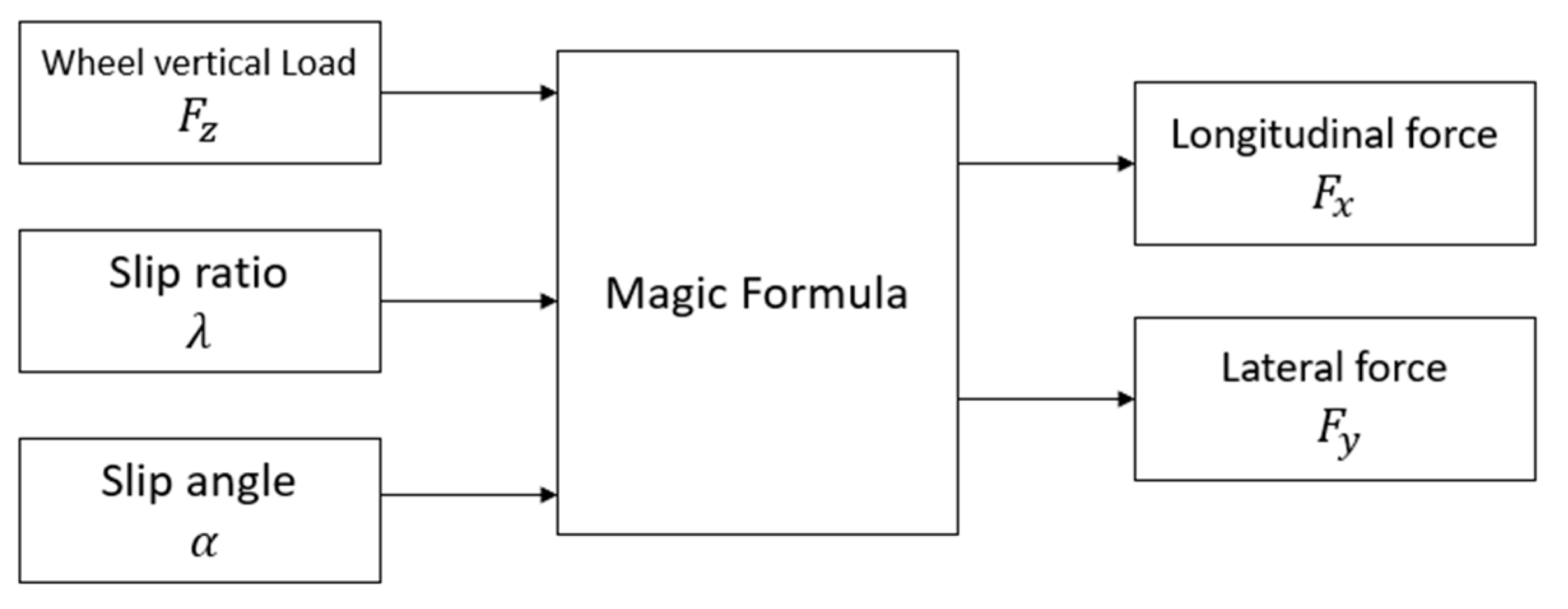
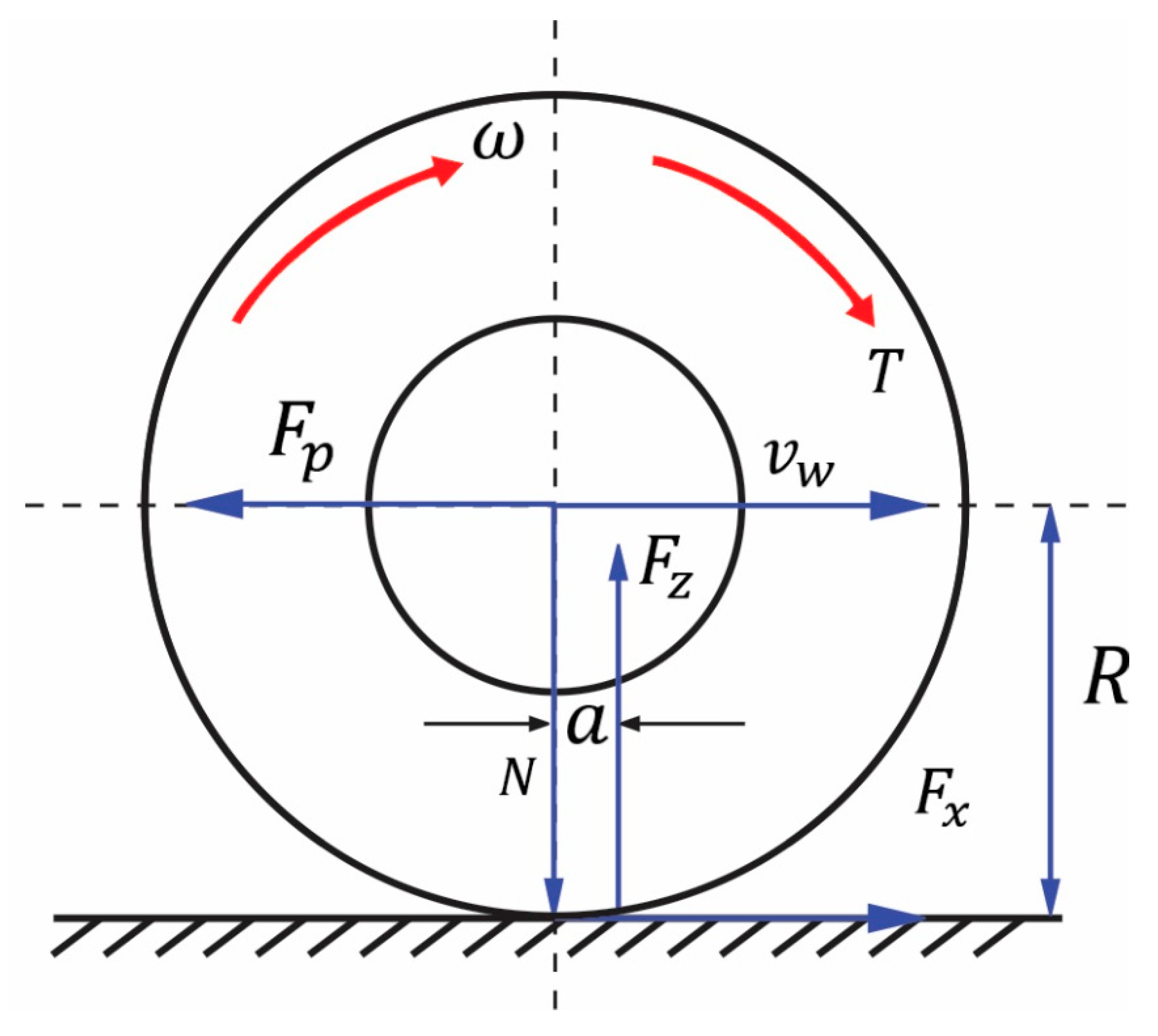
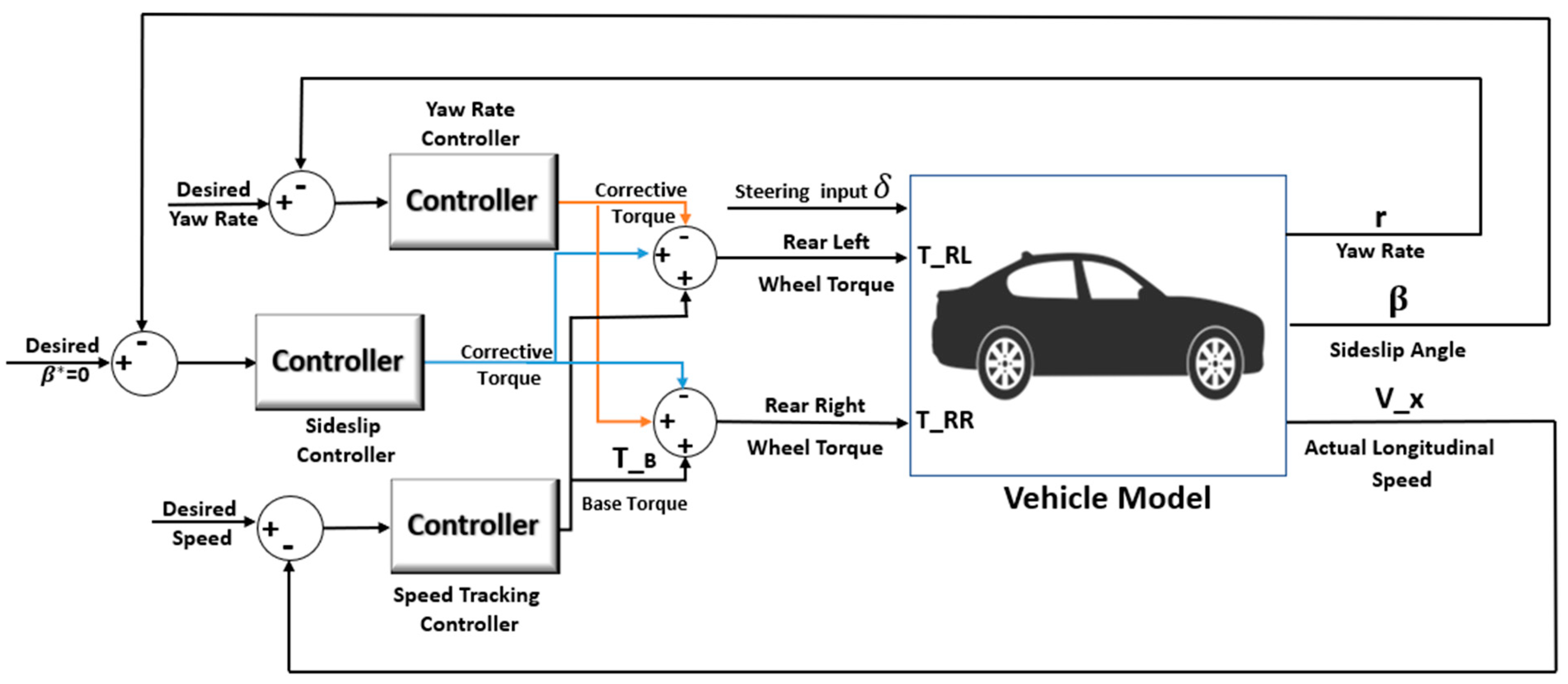
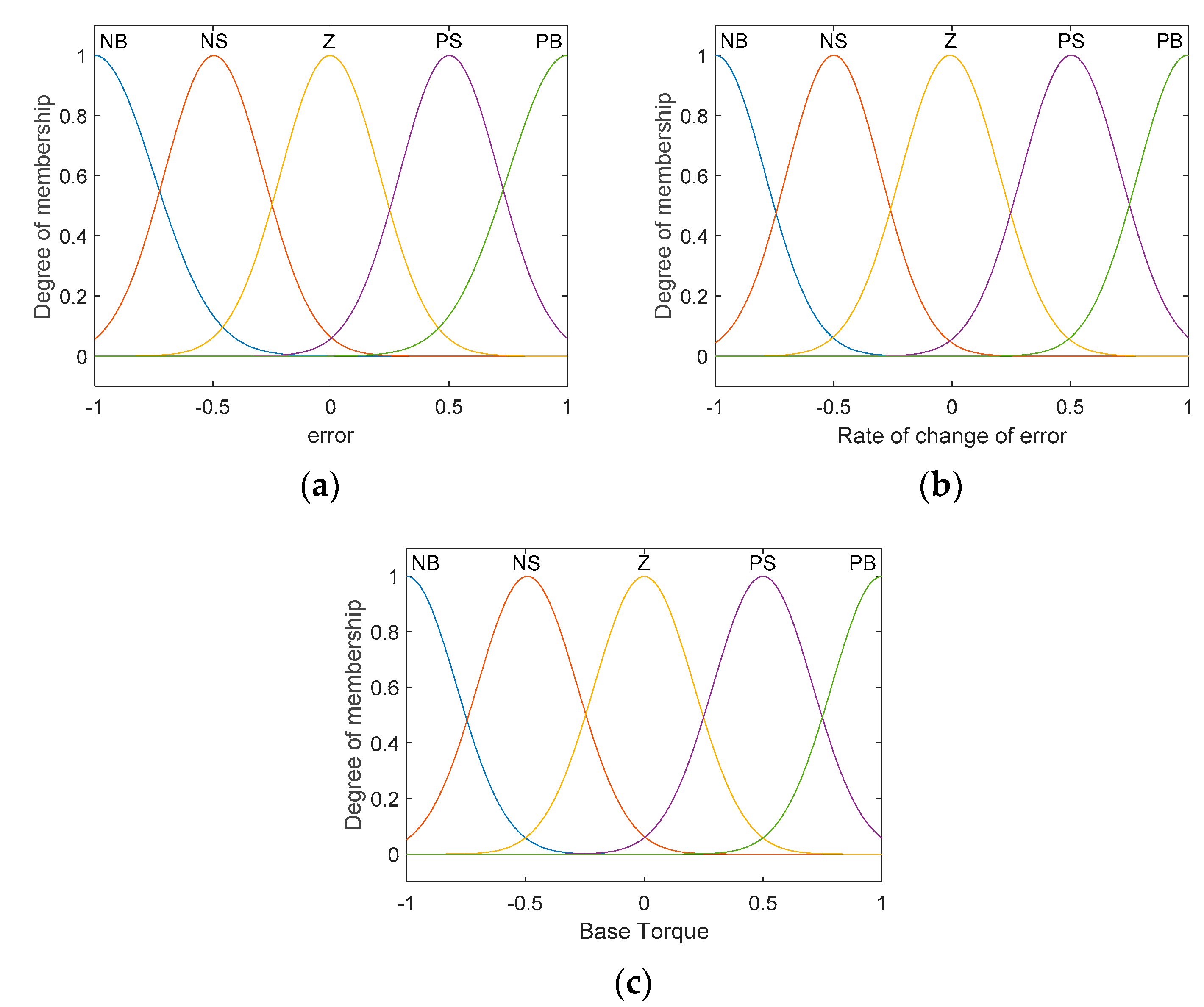
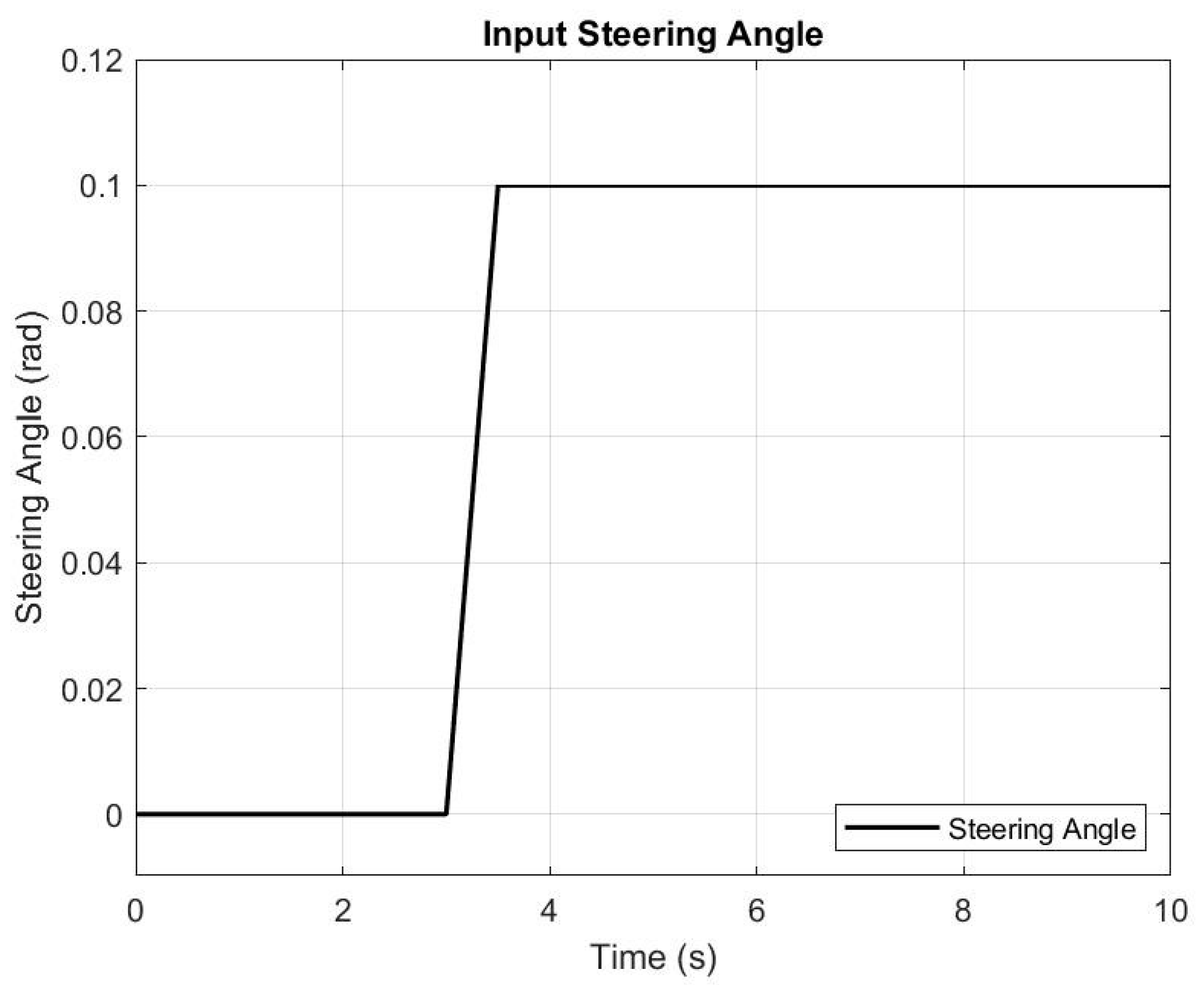
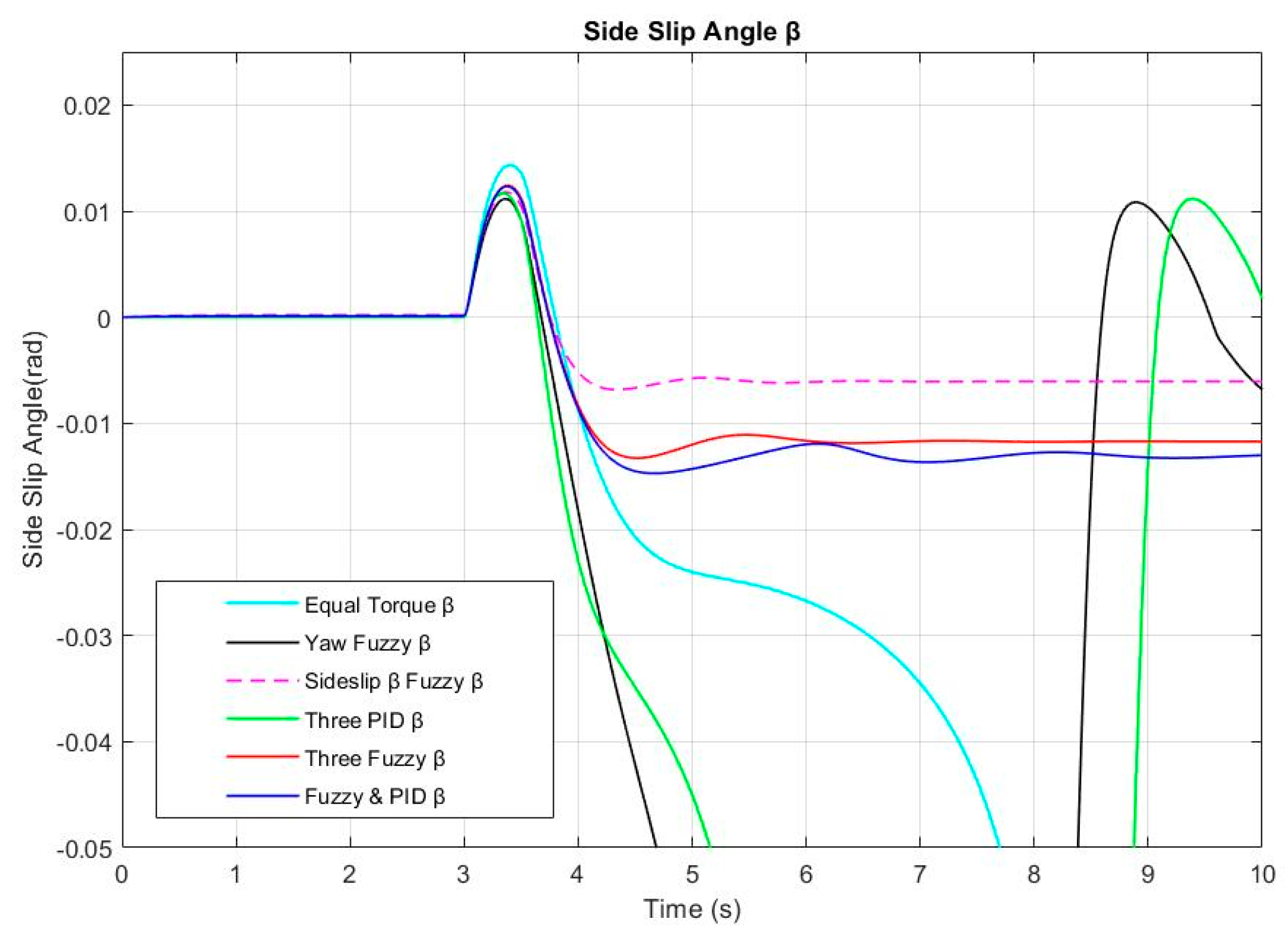
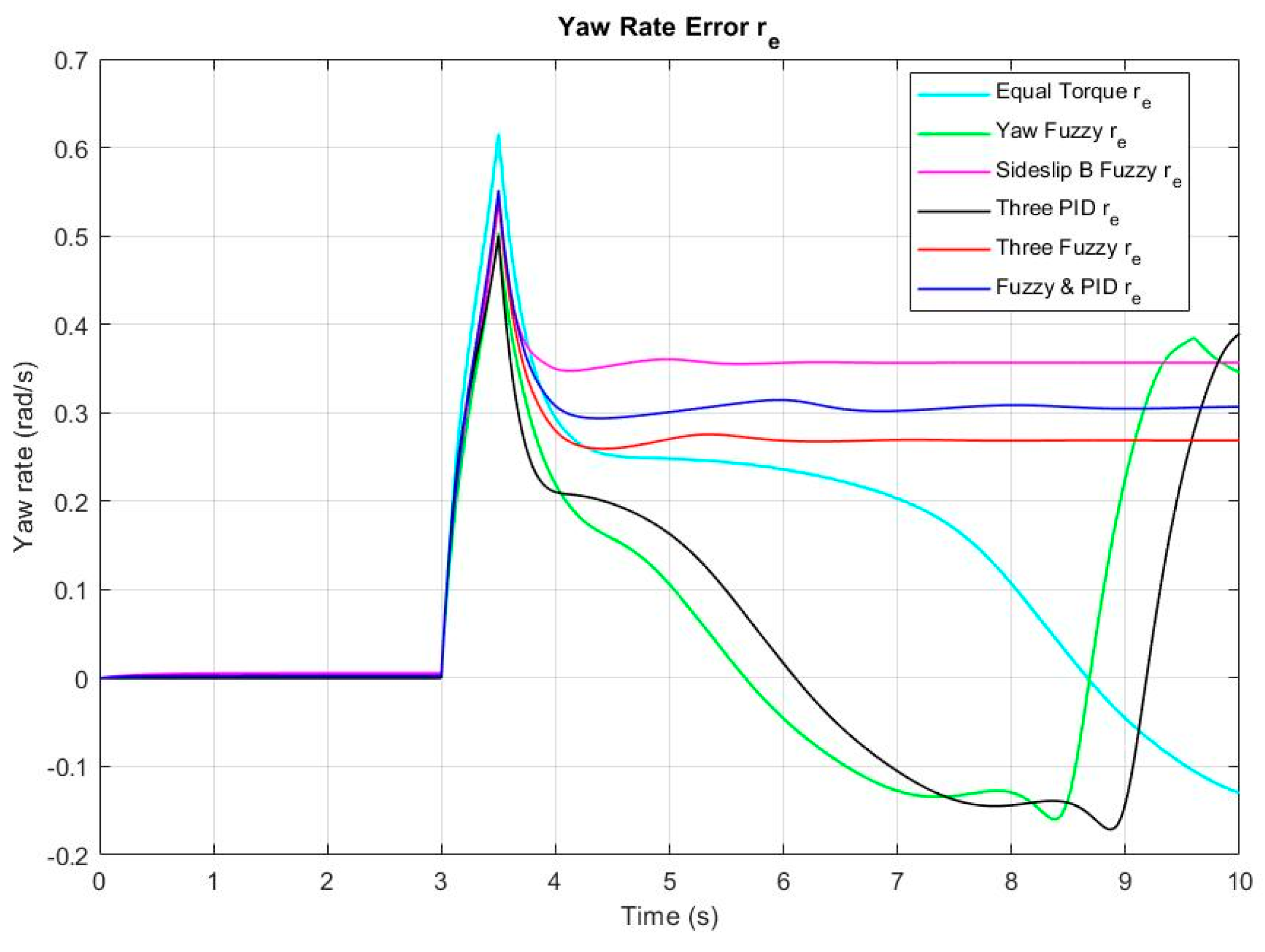
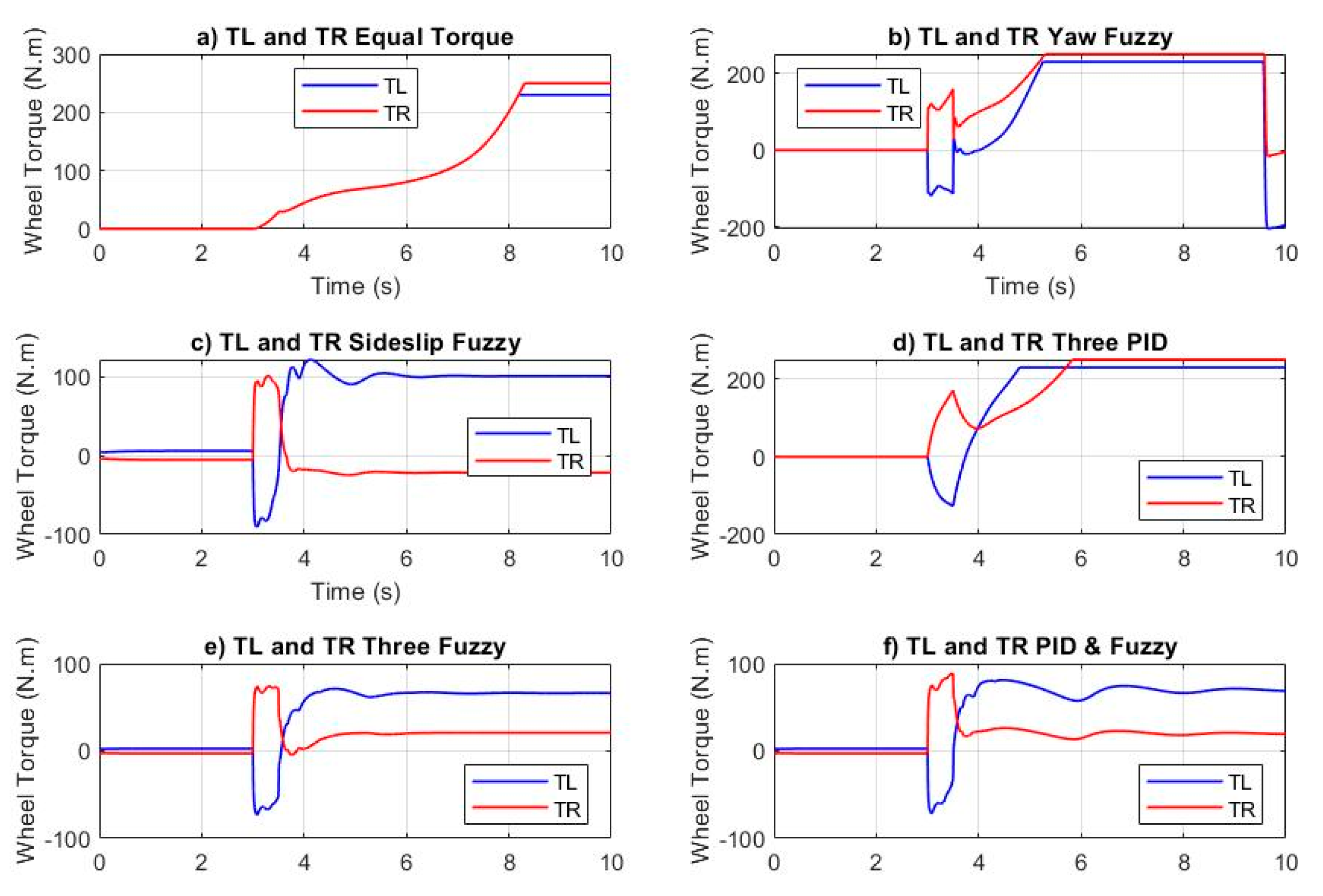
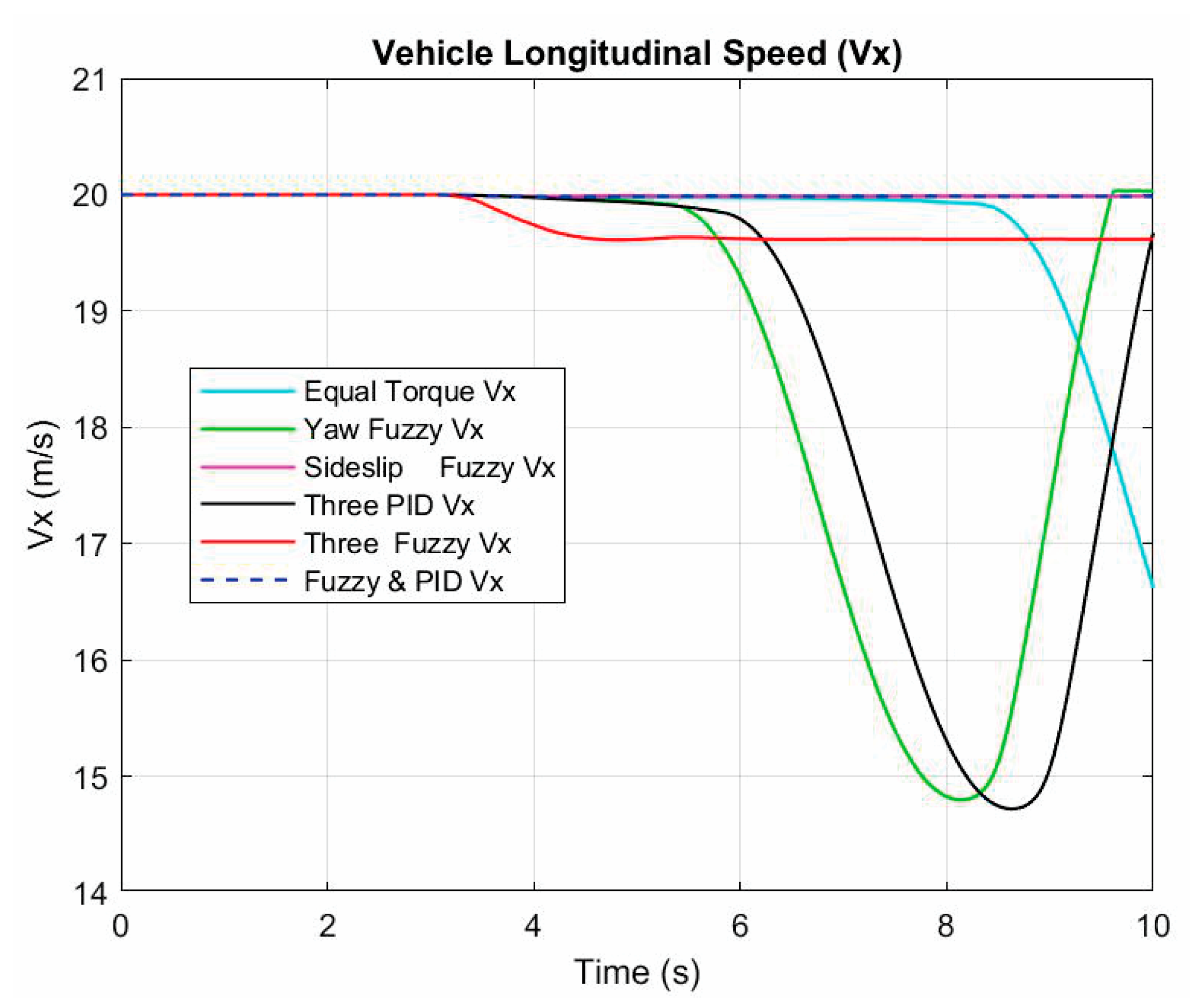
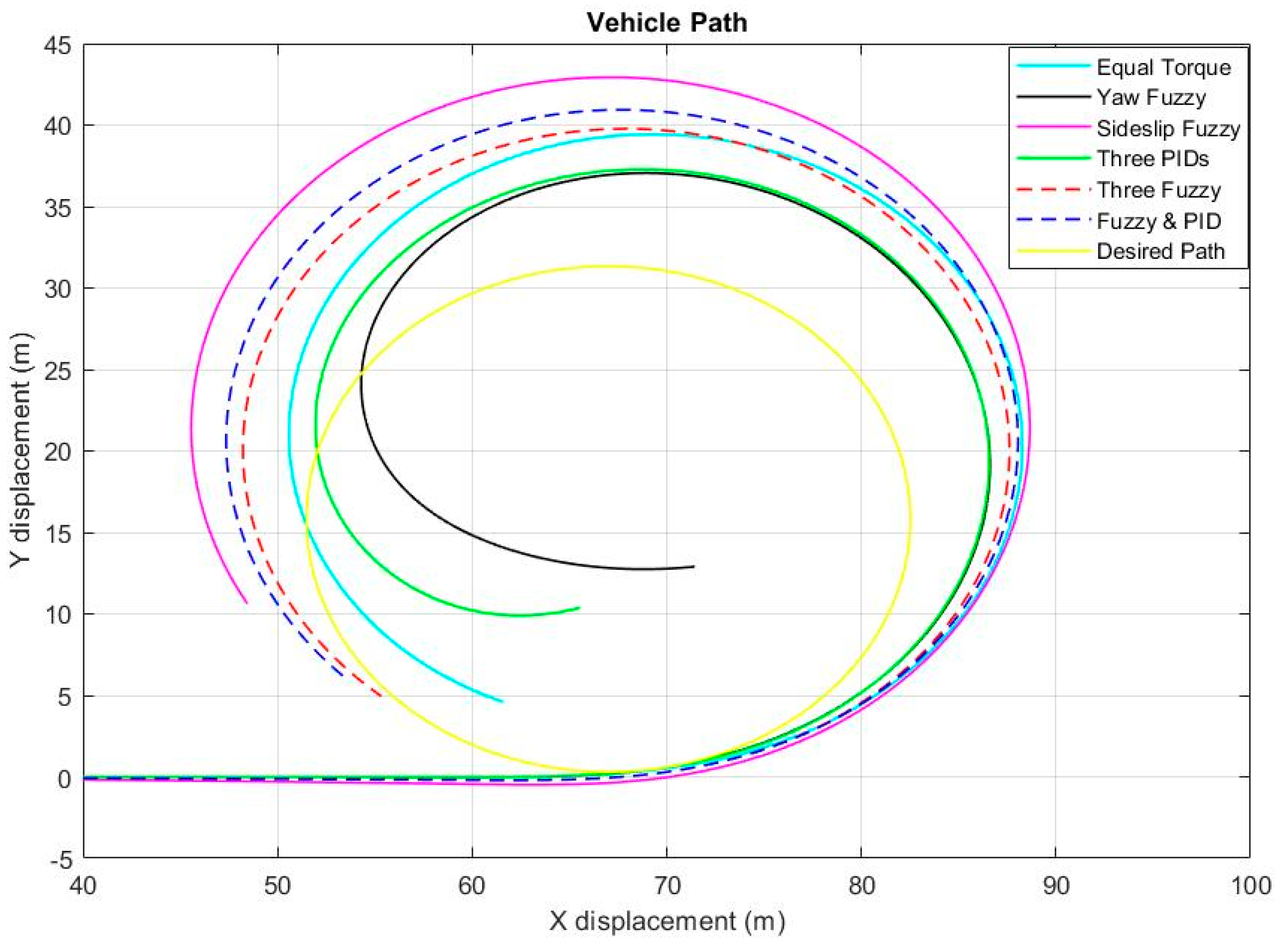
| Description | Gains Symbol | Value |
|---|---|---|
| Speed tracking PID proportional gain | Kp_s | |
| Speed tracking PID integral gain | Ki_s | |
| Speed tracking PID derivative gain | Kd_s | |
| Yaw rate PID proportional gain | Kp_r | |
| Yaw rate PID integral gain | Ki_r | |
| Yaw rate PID derivative gain | Kd_r | |
| Sideslip angle PID proportional gain | Kp_B | |
| Sideslip angle PID integral gain | Ki_B | |
| Sideslip angle PID derivative gain | Kd_B |
| Error Change | NL | NS | Z | PS | PL | |
|---|---|---|---|---|---|---|
| Error | ||||||
| NL | NL | NL | NS | NS | Z | |
| NS | NL | NS | NS | Z | PS | |
| Z | NS | NS | Z | PS | PS | |
| PS | NS | Z | PS | PS | PL | |
| PL | Z | PS | PS | PL | PL | |
Publisher’s Note: MDPI stays neutral with regard to jurisdictional claims in published maps and institutional affiliations. |
© 2022 by the authors. Licensee MDPI, Basel, Switzerland. This article is an open access article distributed under the terms and conditions of the Creative Commons Attribution (CC BY) license (https://creativecommons.org/licenses/by/4.0/).
Share and Cite
Sawaqed, L.S.; Rabbaa, I.H. Fuzzy Yaw Rate and Sideslip Angle Direct Yaw Moment Control for Student Electric Racing Vehicle with Independent Motors. World Electr. Veh. J. 2022, 13, 109. https://doi.org/10.3390/wevj13070109
Sawaqed LS, Rabbaa IH. Fuzzy Yaw Rate and Sideslip Angle Direct Yaw Moment Control for Student Electric Racing Vehicle with Independent Motors. World Electric Vehicle Journal. 2022; 13(7):109. https://doi.org/10.3390/wevj13070109
Chicago/Turabian StyleSawaqed, Laith Sami, and Israa Hasan Rabbaa. 2022. "Fuzzy Yaw Rate and Sideslip Angle Direct Yaw Moment Control for Student Electric Racing Vehicle with Independent Motors" World Electric Vehicle Journal 13, no. 7: 109. https://doi.org/10.3390/wevj13070109
APA StyleSawaqed, L. S., & Rabbaa, I. H. (2022). Fuzzy Yaw Rate and Sideslip Angle Direct Yaw Moment Control for Student Electric Racing Vehicle with Independent Motors. World Electric Vehicle Journal, 13(7), 109. https://doi.org/10.3390/wevj13070109






